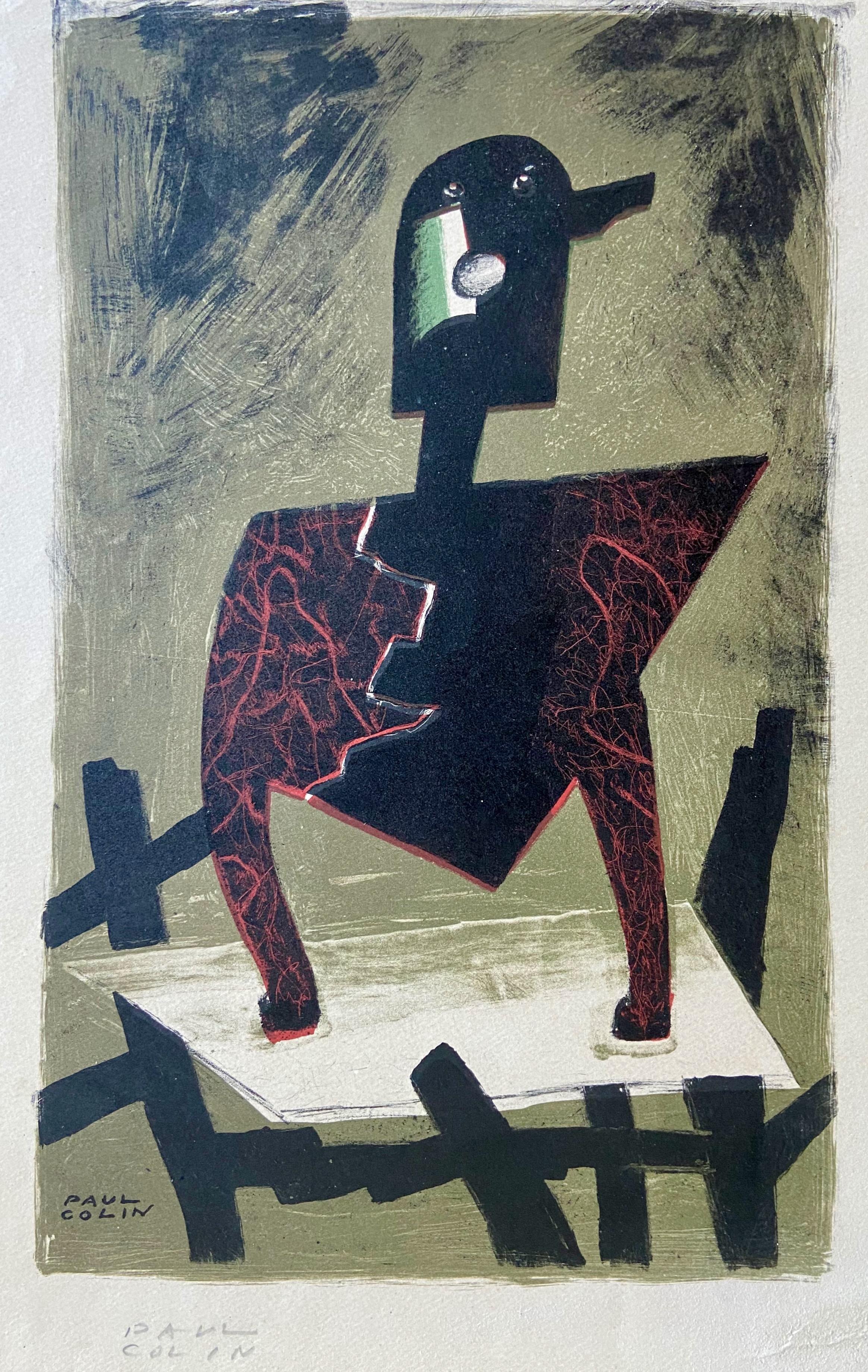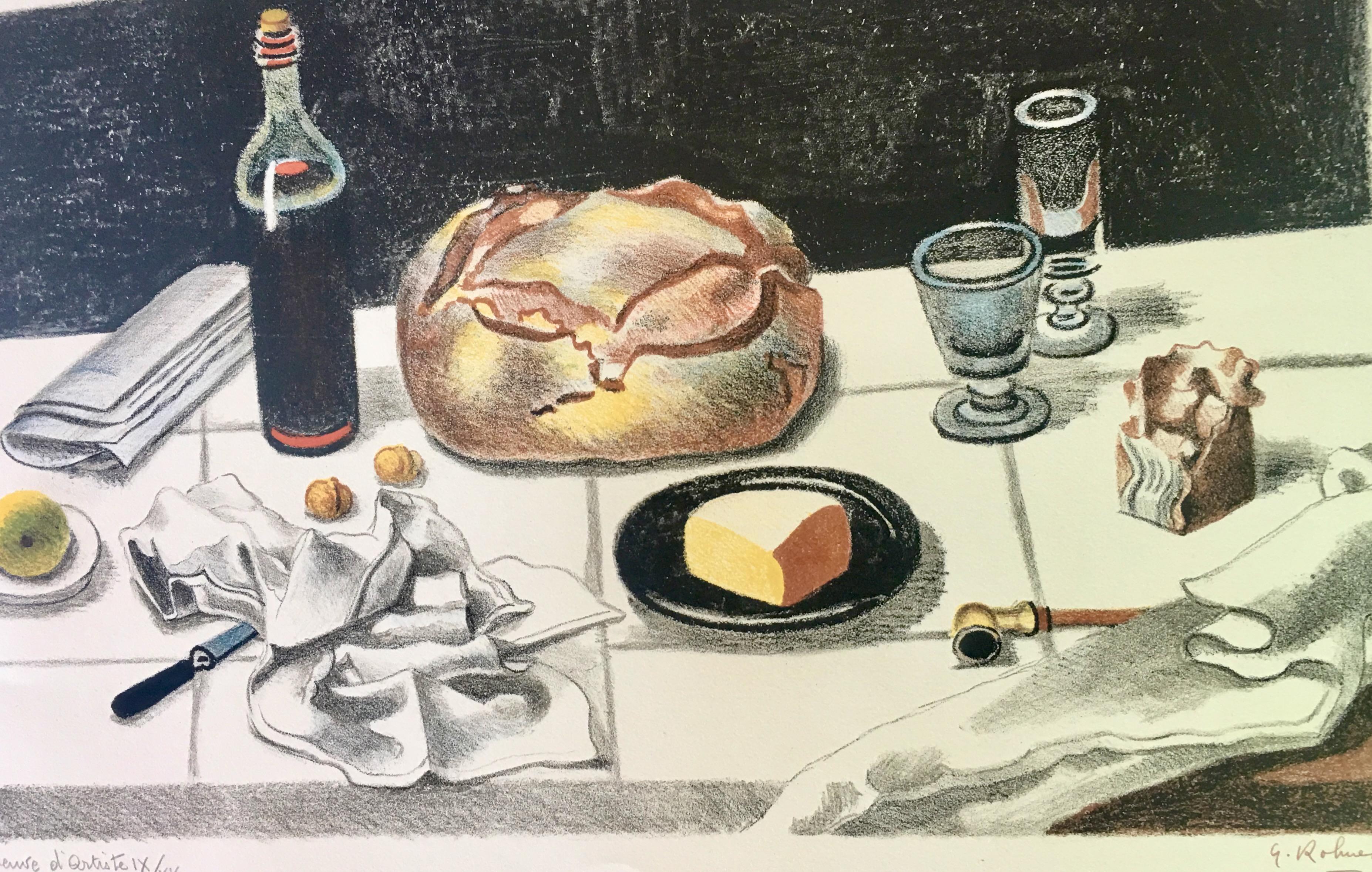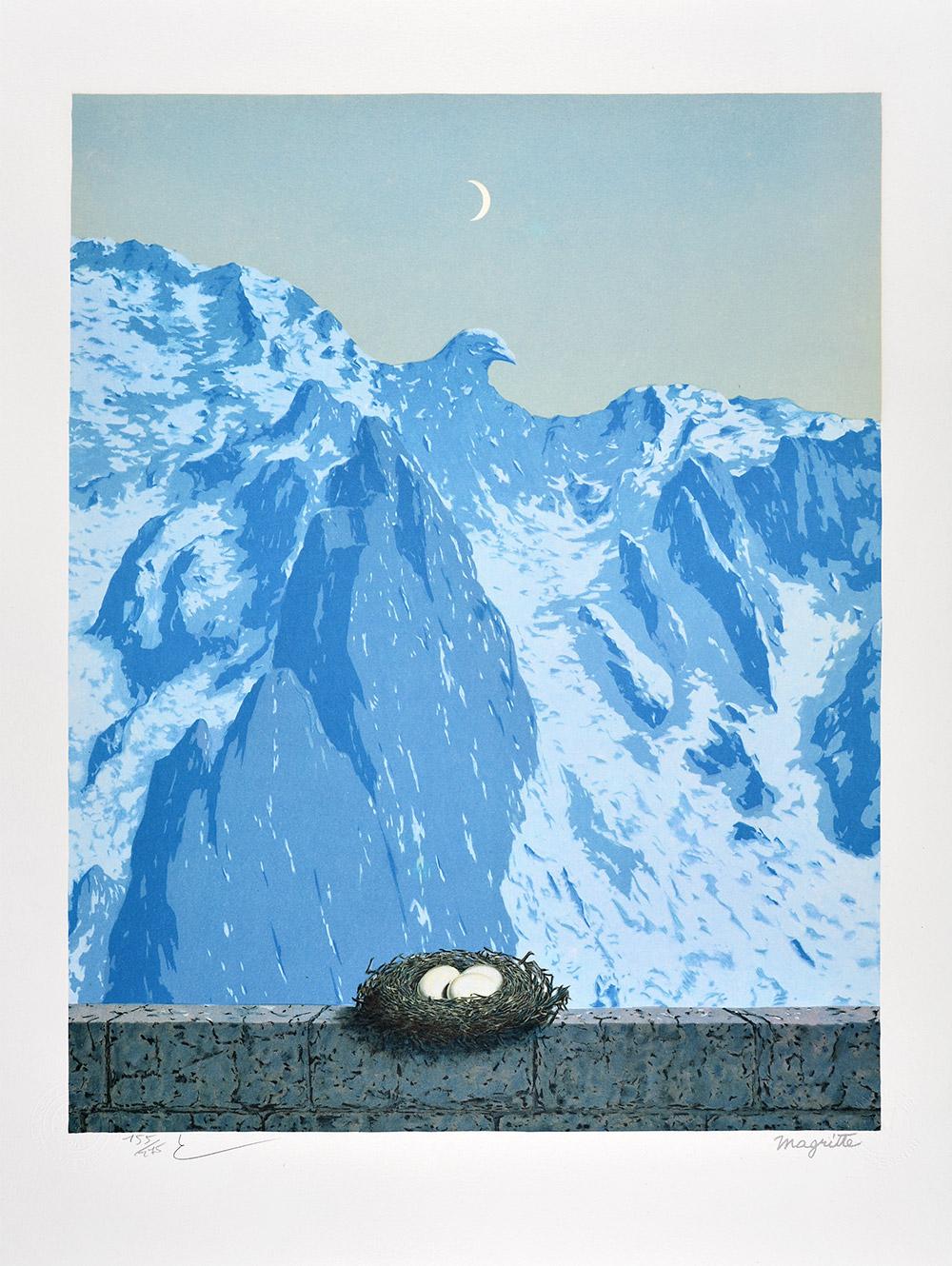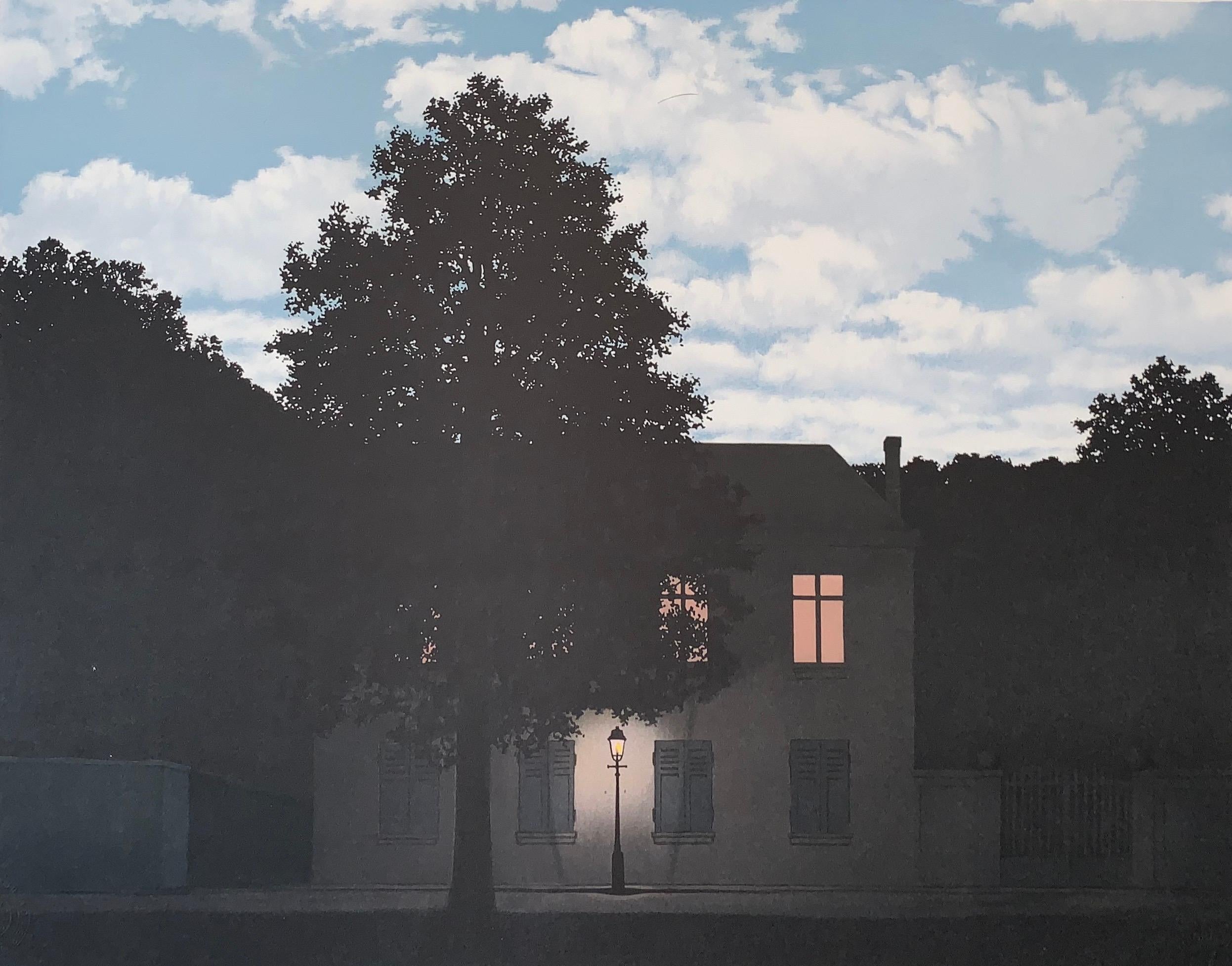Marc Chagall"Ruth aux Pieds de Booz (Ruth at the Feet of Boaz)" Original Colored Lithograph1960
1960
About the Item
- Creator:Marc Chagall (1887 - 1985, French)
- Creation Year:1960
- Dimensions:Height: 25.5 in (64.77 cm)Width: 21.5 in (54.61 cm)
- Medium:
- Movement & Style:
- Period:
- Condition:
- Gallery Location:Milwaukee, WI
- Reference Number:
Marc Chagall
Described by art critic Robert Hughes as "the quintessential Jewish artist of the twentieth century," the Russian-French modernist Marc Chagall worked in nearly every artistic medium. Influenced by Symbolism, Fauvism, Cubism and Surrealism, he developed his own distinctive style, combining avant-garde techniques and motifs with elements drawn from Eastern European Jewish folk art.
Born Moishe Segal in 1887, in Belarus (then part of the Russian empire), Chagall is often celebrated for his figurative paintings, but he also produced stained-glass windows for the cathedrals of Reims and Metz, in France; for the United Nations, in New York; and for the Hadassah Hospital in Jerusalem, as well as book illustrations, stage sets, ceramics, tapestries and fine-art prints. Characterized by a bold color palette and whimsical imagery, his works are often narrative, depicting small-village scenes and quotidian moments of peasant life, as in his late painting The Flight into Egypt from 1980.
Before World War I, Chagall traveled between St. Petersburg, Paris and Berlin. When the conflict broke out, he returned to Soviet-occupied Belarus, where he founded the Vitebsk Arts College before leaving again for Paris in 1922. He fled to the United States during World War II but in 1947 returned to France, where he spent the rest of his life. His peripatetic career left its mark on his style, which was distinctly international, incorporating elements from each of the cultures he experienced.
Marc Chagall remains one of the past century’s most respected talents — find his art on 1stDibs.
- ShippingRetrieving quote...Ships From: Milwaukee, WI
- Return PolicyA return for this item may be initiated within 14 days of delivery.
- "Le Bouquet tout fait (The Ready-made Bouquet), " Lithograph after Rene MagritteBy René MagritteLocated in Milwaukee, WI"Le Bouquet tout fait (The Ready-made Bouquet)" is a color lithograph after a 1954 original painting by Rene Magritte. A bourgeois "little man" faces away from the viewer looking towards a fall forest. Flora, the goddess of flowers and season of spring, from Sandro Botticelli's "Primavera" is painted on the back of the man. This juxtaposes fall and spring. Art: 12 x 9.75 in Frame: 22.38 x 20.38 in René-François-Ghislain Magritte was born November 21, 1898, in Lessines, Belgium and died on August 15, 1967 in Brussels. He is one of the most important surrealist artists. Through his art, Magritte creates humor and mystery with juxtapositions and shocking irregularities. Some of his hallmark motifs include the bourgeois “little man,” bowler hats, apples, hidden faces, and contradictory texts. René Magritte’s father was a tailor and his mother was a miller. Tragedy struck Magritte’s life when his mother committed suicide when he was only fourteen. Magritte and his two brothers were thereafter raised by their grandmother. Magritte studied at the Brussels Academy of Fine Arts from 1916 to 1918. After graduating he worked as a wallpaper designer and in advertisement. It was during this period that he married Georgette Berger, whom he had known since they were teenagers. In 1926, René Magritte signed a contract with the Brussels Art Gallery, which allowed him to quit his other jobs and focus completely on creating art. A year later he had his first solo show at the Galerie la Centaurie in Brussels. At this show Magritte exhibited what is today thought of as his first surrealist piece, The Lost Jockey, painted in 1926. In this work a jockey and his steed run across a theater stage, curtains parted on either side. Throughout the scene, there are trees with trunks shaped somewhat like chess pawns with musical scores running vertically up their sides and branches sticking out from all angles. Critics did not enjoy this style of art; it was new, different, and took critical thought to understand, but The Lost Jockey was only the first of many surrealist artworks Magritte would paint. Because of the bad press in Brussels, René and Georgette moved to Paris in 1927, with the hope that this center of avant-garde art would bring him success and recognition. In Paris, he was able to become friends with many other surrealists, including André Breton and Paul Éluard. They were able to learn from and inspire one another, pushing the Surrealist movement further forward. It was also in Paris that Magritte decided to add text to some of his pieces, which was one of the elements that made his artwork stand out. In 1929, he painted one of his most famous oil works: The Treachery of Images. This is the eye-catching piece centered on a pipe. Below the pipe is written “Ceci n’est pas un pipe,” which translates to “This is not a pipe.” This simple sentence upset many critics of the time, for of course it was a pipe. Magritte replied that it was not a pipe, but a representation of a pipe. One could not use this oil on canvas as a pipe, to fill it with tobacco and smoke it. Thus, it was not a pipe. In 1930, Magritte and Georgette moved back to Brussels. Though they would travel to his exhibitions elsewhere, their home going forward would always be in Brussels. Magritte had his first American exhibition at the Julien Levy Gallery in New York City in 1936 and his first show in England two years later in 1938 at The London...Category
2010s Surrealist Figurative Prints
MaterialsLithograph
- "La Grande Guerre (The Great War), " Color Lithograph after Rene MagritteBy René MagritteLocated in Milwaukee, WI"La Grande Guerre (The Great War)" is a color lithograph after the 1964 painting by Rene Magritte. A Victorian lady stands in white facing the viewer. A bouq...Category
2010s Surrealist Figurative Prints
MaterialsLithograph
- "Vanity Fair (The Face Off) Recto, Camel Cigarette Verso, " by Paolo GarrettoBy Paolo GarrettoLocated in Milwaukee, WIThis double-sided lithograph by Paolo Garretto features a Vanity Fair cover "The Face Off" on the front and a Camel Cigarette ad on the back. It was pu...Category
1930s Surrealist Figurative Prints
MaterialsLithograph
- "A Multiple of Gaudy and Fantastic Appearances from Edgar Allen Poe..."By Federico CastellonLocated in Milwaukee, WI"A Multiple of Gaudy and Fantastic Appearances" from "Edgar Allen Poe's Mask of the Read Death" is an original lithograph by Frederico Castellon. The artist ...Category
1960s Surrealist Figurative Prints
MaterialsLithograph
- "Erotica III Marginala, " from the Mask of the Red Death series signed CastellonBy Federico CastellonLocated in Milwaukee, WIThis lithograph was one of sixteen Federico Castellón produced in 1968, published by Aquarius Press, to illustrate Edgar Allan Poe's 1832 story 'The Mask of the Red Death.' The image...Category
1960s Surrealist Figurative Prints
MaterialsLithograph
- "La race blanche (The White Race), " Lithograph after Painting by Rene MagritteBy René MagritteLocated in Milwaukee, WI"La race blanche (The White Race)" is a color lithograph after the original 1937 painting by Rene Magritte. A female figure is made out of a mix of body parts. An eye sits on top of an ear, which is on top of a mouth, then two noses. Two breasts lying on a stomach; two arms come from the breasts. Legs are tucked under the stomach. This figure is on a sand dune next to the ocean. Art: 26.5 x 19.63 in Frame: 40.88 x 33.88 in René-François-Ghislain Magritte was born November 21, 1898, in Lessines, Belgium and died on August 15, 1967 in Brussels. He is one of the most important surrealist artists. Through his art, Magritte creates humor and mystery with juxtapositions and shocking irregularities. Some of his hallmark motifs include the bourgeois “little man,” bowler hats, apples, hidden faces, and contradictory texts. René Magritte’s father was a tailor and his mother was a miller. Tragedy struck Magritte’s life when his mother committed suicide when he was only fourteen. Magritte and his two brothers were thereafter raised by their grandmother. Magritte studied at the Brussels Academy of Fine Arts from 1916 to 1918. After graduating he worked as a wallpaper designer and in advertisement. It was during this period that he married Georgette Berger, whom he had known since they were teenagers. In 1926, René Magritte signed...Category
Early 2000s Surrealist Figurative Prints
MaterialsLithograph
- Nature morte still life, original lithographBy Georges RohnerLocated in Belgrade, MTGeorges Rohner ( French, 1913-2000)was a Paris born painter and printmaker of international repute. Known stylistically as a realist, his creative endeavors often edged toward surre...Category
Mid-20th Century Surrealist Still-life Prints
MaterialsLithograph
- untitled, originalBy Paul ColinLocated in Belgrade, MTThis piece is a limited edition, pencil signed by the artist on the print and in the plate. It is part of my private collection of artists from the School of Paris era. It is in very...Category
Mid-20th Century Surrealist Figurative Prints
MaterialsEngraving, Lithograph
- René Magritte - LE DOMAINE D'ARNHEIM Limited Surrealism French ContemporaryBy (after) René MagritteLocated in Madrid, MadridRené Magritte - LE DOMAINE D'ARNHEIM, 1962 (THE DOMAIN OF ARNHEIM) Date of creation: 2010 Medium: Lithograph on BFK Rives Paper Edition number: 155/275 Size: 60 x 45 cm Condition: Ne...Category
Mid-20th Century Surrealist Figurative Prints
MaterialsPaper, Lithograph
- René Magritte - LE CHEF D'OEUVRE OU... Limited Surrealism French ContemporaryBy (after) René MagritteLocated in Madrid, MadridRené Magritte - LE CHEF D'OEUVRE OU LES MYSTÈRES DE L'HORIZON, 1965 Date of creation: 2010 Medium: Lithograph on BFK Rives Paper Edition number: 131/275 Size: 60 x 45 cm Condition: N...Category
Mid-20th Century Surrealist Figurative Prints
MaterialsLithograph
- Magritte Portfolio V 20 lithographs- 20th Century, Surrealist, Figurative PrintBy (after) René MagritteLocated in Sint-Truiden, BEComplete set of 20 color lithographs in a beautiful burgundy board with ties, plate-signed by Magritte and numbered from the edition of 275. The lithograph features the dry stamps of the Magritte Foundation & ADAGP and is countersigned in pencil by Mr. Charly Herscovici, President of the Magritte Foundation, Chairman of the Magritte Museum and unique representative of the Magritte Succession. A proof of edition is printed on the back of the lithograph, guaranteeing its authenticity. Magritte was a Belgian surrealist artist whose witty and thought-provoking images challenged observers? preconditioned perceptions of reality. Magritte's work frequently displays a juxtaposition of ordinary objects in an unusual context, giving new meanings to familiar things.Magritte grew up in a simple and somewhat tragic household. His father was a modest tailor. His mother, who was mentally unsound, committed suicide in the year 1912. Magritte started drawing at a young age, and his first paintings, produced c. 1915, were Impressionistic in style.Magritte first worked as a draughtsman in a wallpaper factory and, in the year 1922, fell in love with and married Georgette Berger. In 1926, Magritte signed...Category
20th Century Surrealist Figurative Prints
MaterialsLithograph
- L'Empire des Lumières - 20th Century, Surrealist, Lithograph, Figurative PrintBy (after) René MagritteLocated in Sint-Truiden, BEColor lithograph after the 1961 oil on canvas by René Magritte, printed signature of Magritte and numbered from the edition of 300. The lithograph features the dry stamps of the Mag...Category
20th Century Surrealist Figurative Prints
MaterialsLithograph





